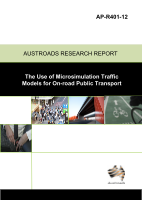Traffic Management

The Use of Microsimulation Traffic Models for On-road Public Transport
- Publication no: AP-R401-12
- ISBN: 978-1-921991-18-9
- Published: 16 March 2012
- PDF (free) Download
This study looked into four on-road public transport (ORPT) priority treatments including: full bus lane (FBL), set back bus lane (SBBL), queue jump bus lane (QJBL) and no priority (NP). Microsimulation traffic modelling (MSTM) is a useful tool for controlled comparative studies for ORPT priority treatments. The purpose of this study is to enable a more consistent approach to the application of MSTM to ORPT priority analysis and improve network planning for ORPT. It was also the purpose of this study to better understand ORPT priority schemes by controlled comparative studies using MSTM.
- 1. INTRODUCTION
- 2. MICROSIMULATION MODELLING OF ORPT
- 2.1. Selecting the Appropriate Modelling Technique
- 2.2. Organising a Microsimulation Study for ORPT Analysis
- 3. REVIEW OF SELECTED ORPT PRIORITY SCHEMES
- 3.1. Set Back Bus Lane (SBBL)
- 3.2. Queue Jump Bus Lane (QJBL)
- 3.3. Signal Priority for Set Back and Queue Jump Bus Lanes
- 3.4. Bus Priority Scenarios for MSTM Study
- 4. MICROSIMULATION MODELS FOR ORPT ANALYSIS
- 4.1. Base Model
- 4.2. Set Back Bus Lane Models
- 4.3. Queue Jump Bus Lane Models
- 5. SIMULATION RESULTS
- 5.1. Comparison of Selected Bus Priority Schemes
- 5.2. Set Back Bus Lane Model Results
- 5.3. Queue Jump Bus Lane Model Results
- 5.4. Summary of Findings
- 6. CONCLUSION AND RECOMMENDATIONS
Related publications
WEB-GADA-24
WEB-R695-G104-2-23
Latest Traffic Management News
